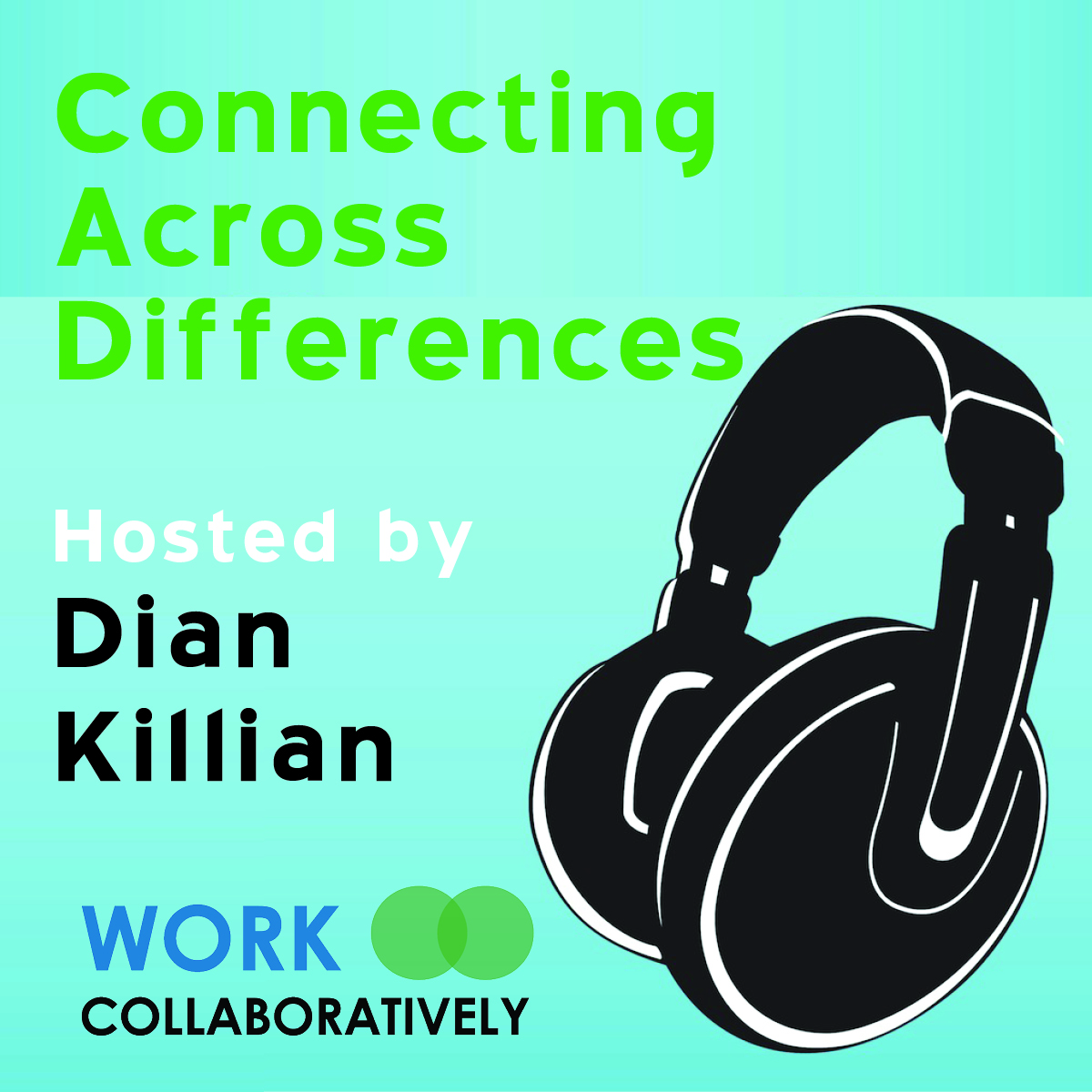
Connecting Across Differences is a podcast created by Dian Killian, Ph.D. of Work Collaboratively about having greater empathy for yourself and others, and how to hear others more deeply and make sure that you’ve been heard. Episodes are available on iTunes.
Listen to Episode 3:
On this episode of the podcast, we focus on self-empathy (also known as self-management). Self-empathy is a key skill in internally navigating how we respond to situations and to have greater choice and connection when we’re responding to others, especially in situations where we’re triggered or the other person is triggered.
On the podcast, Dian shares a story from her book Urban Empathy. If you have a copy of the book, you can reference the story, “The Cooperative” on page 38. In this story, Dian is shopping at her local food co-op when she encounters a woman who accuses Dian of breaking one of the co-op’s rules. The woman is screaming at Dian, repeating the same things over and over again.
While the woman continued to yell accusations, Dian took this as an opportunity to practice self-empathy by taking a moment to check in with herself about how she was feeling and what needs were up for her in relation to what was going on with the woman who is upset.

Dian also acknowledged her judgments. Noticing your judgments is a really helpful place to start in practicing self-empathy. It doesn’t necessarily mean you have to share your judgments out loud with the other person. In fact, you probably want to avoid that, since the other person may not enjoy hearing your judgments. 🙂
Dian noticed that she was having thoughts like, “this is ridiculous… I didn’t break the rules… ! She’s obviously in a bad mood and taking things out on me…. I don’t even want to be having this conversation because I’m here with a friend who is visiting from out of town and I much rather be spending time with her than being in conflict with this woman — especially when I don’t even think her accusations are correct!!”
Once Dian got to that point internally and was clear on how she was feeling, then she spoke up and said, “Excuse me, I notice I’m hearing you say things you said two or three minutes ago. I’m wondering if you’d like me to tell you what I’ve heard you say so far, so you can be sure that I’ve heard you?” The woman responded with a dropped jaw in shock, paused, and said, “No, actually.” Dian then replied, “Okay, then I’m taking that to mean that you said everything you wanted me to hear and I’m going back to my cart.”
For Dian, that was a much preferable solution than having to engage with the woman that could have escalated into an arguing match. This solution provided closure and also gave each person a choice. None of this would have been possible without self-empathy.
What is involved with practicing self-empathy?
The first step is noticing your judgments. When we listen to our judgments, they often point us in the direction of what we’re feeling and needing. For example, when Dian was telling herself, “I don’t even want to be talking to this woman!” it helped to get clear that she was feeling frustrated and wanted choice.
Once we’ve identified our feelings and needs, we can choose a strategy based on those feelings and needs that will best meet our needs. In “The Cooperative” example, Dian’s strategy was asking the woman if she had anything more to say and if she wanted her to recap what she’d heard. That was Dian’s way of having closure on the confrontation and having the choice to disengage.
Another skill set Dian used in the co-op example is giving clear observations. You can learn more about forming clear observations on episode one of this podcast. Dian also used “recapping” —also commonly referred to as mirroring or reflection. Recapping is basically giving a headline of what you heard the person say and is a form of observation.
Why practice self-empathy?
Self-empathy has a lot of different applications. On a broad level, it’s very helpful to practice self-empathy when talking with other people before you respond to them so you can be in choice about how you respond to the situation. Another circumstance where having self-empathy can be practice is when we’re having judgments of ourselves. The story, “F-ing Strategies,” in the Urban Empathy book illustrates self-empathy when experiencing inner judgment. There are many other examples of self-empathy being practiced in Urban Empathy. We will explore other examples in later episodes.
Self-empathy can really make a difference in how we respond to other people. It also can make a difference when we’re having judgments of ourselves.
Here’s a challenge for you this week:
The next time you notice yourself having a strong response to something, whether positive or negative take a moment to practice self-empathy. If you’re actually in conversation with someone, you can silently connect with yourself about your own feelings and needs. You can also excuse yourself from the situation and tell the person you need a few moments before you can come back to the conversation.
Self-connection index
Check in with yourself. On a scale from 1 – 10 how angry or triggered are you? Once you’ve practiced self-empathy and have gotten clear about your feelings and needs, check in with yourself again and see where you are on that scale again. Were you able to re-calibrate and return to stasis?
We’d love to hear what you’ve discovered! Feel free to post to the Work Collaboratively Facebook page. How did practicing self-empathy work for you? How did it make a difference for you in a difficult situation? Were you able to have more compassion for yourself or the person involved? Was your response different than had you not self-connected with your feelings and needs?
You can also subscribe to the Connecting Across Differences podcast on iTunes. Please be sure to leave a review if you enjoyed the episode!
Thanks for listening. If you’re enjoying our podcasts, please share them with your friends and family. The more people in your life who know how to connect with their feelings and needs, the easier you’ll find it to connect with them and come up with solutions that work for everyone involved!
Pingback: Curiosity, The Art of Waiting, and Finding Peace | Work Collaboratively